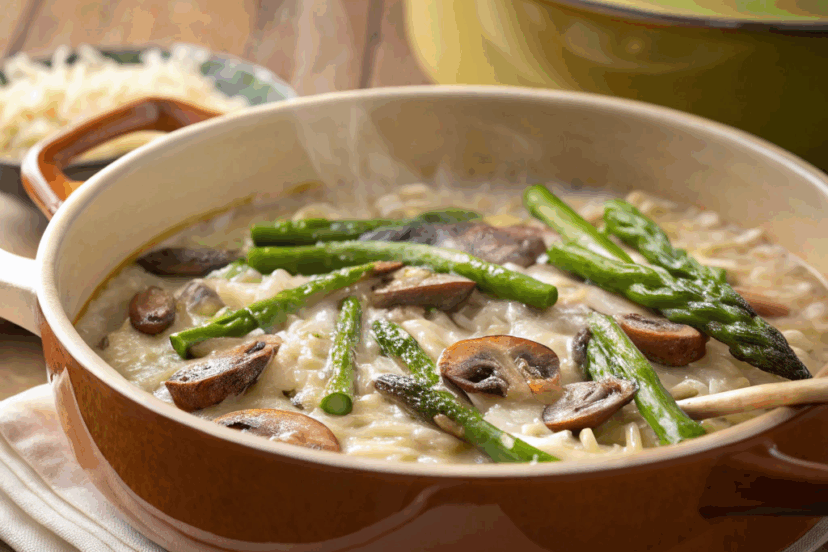Asparagus Mushroom Risotto Recipe | Super Creamy
There’s something magical about stirring a pot of risotto. The rhythmic motion, the gradual transformation of simple ingredients into something extraordinary – it’s like meditation in motion. I accidentally discovered asparagus mushroom risotto during a spring evening when I had nothing but leftover vegetables and a bag of arborio rice in my pantry. What started as an experiment became my signature dish, one that friends now request every time they visit.
The aroma of earthy mushrooms mingling with fresh asparagus, the steam rising from the pot, and that first taste of perfectly creamy risotto – it’s pure comfort food magic. Today, I’m sharing everything I’ve learned about creating the perfect asparagus mushroom risotto, from its Italian origins to modern adaptations that suit every dietary need.
Do You Know the History Behind Risotto?
Risotto originated in Northern Italy during the 14th century, particularly in the regions of Lombardy and Piedmont. The technique of slowly cooking short-grain rice in broth while constantly stirring creates that signature creamy texture that makes risotto so beloved worldwide.
How Spring Ingredients Became a Classic Combination
The pairing of asparagus and mushrooms in risotto isn’t just coincidental – it’s rooted in seasonal Italian cooking traditions. Spring brings fresh asparagus shoots, while mushrooms foraged from forest floors complement their delicate flavor perfectly. This combination represents the essence of Italian cuisine: using the best seasonal ingredients to create something greater than the sum of its parts.
Traditional Italian cooks would gather at the farmers market early in the morning, selecting the finest fresh vegetables for their evening meals. The cooking process itself became a family affair, with everyone taking turns stirring the pot while sharing stories of their day.
What Makes a Perfect Creamy Risotto
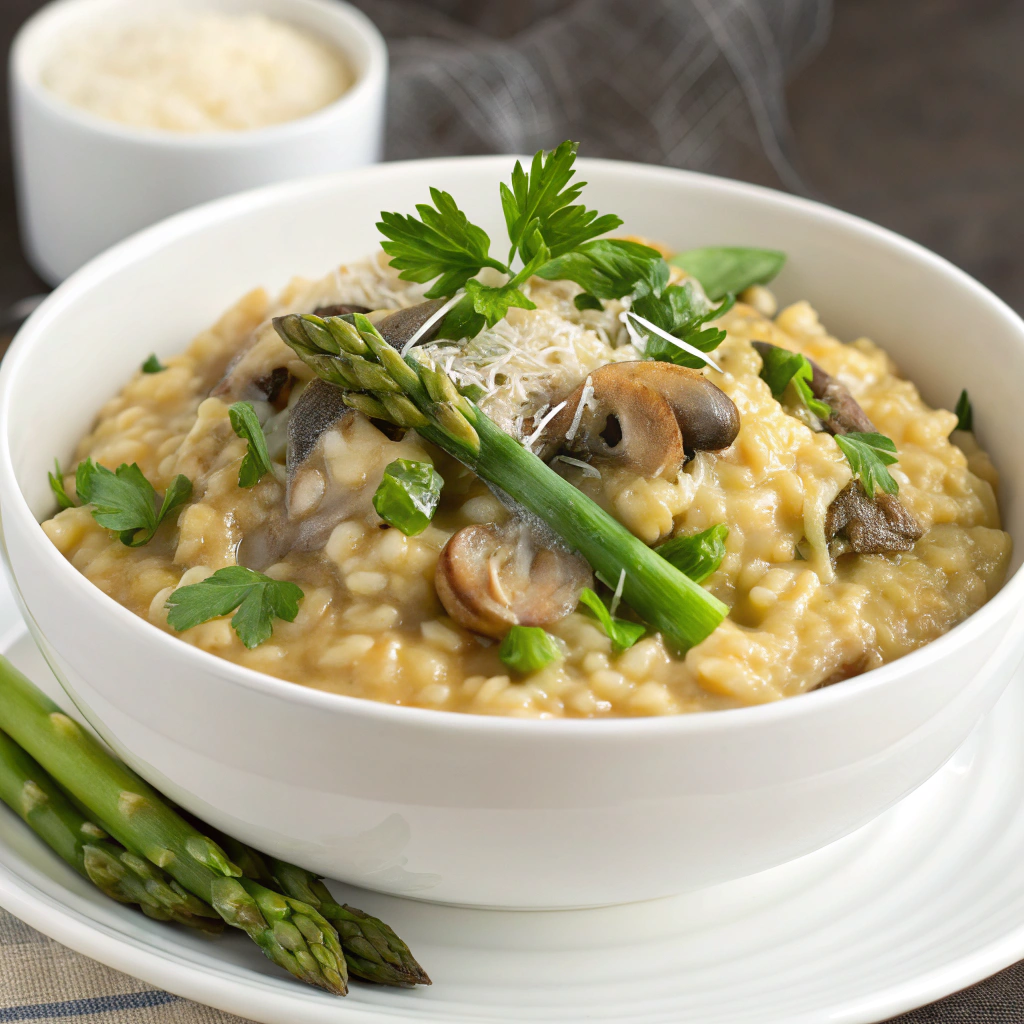
Before diving into my asparagus mushroom risotto recipe, let’s understand what makes risotto special. The key lies in the starch content of arborio rice (sometimes spelled aborio rice in older texts). This short-grain rice releases starch gradually during the cooking process, creating that coveted creamy texture without needing heavy cream.
Why Technique Matters More Than Ingredients
The best way to achieve perfect risotto is through proper technique, not expensive ingredients. The constant stirring releases starch from the rice grains, while adding warm broth one ladle at a time ensures even cooking. This isn’t just tradition – it’s science working in your favor.
Essential Equipment for Your Asparagus Mushroom Risotto
Having the right tools makes all the difference in creating the perfect risotto. Here’s what you’ll need:
Must-Have Equipment:
- Large saucepan or medium saucepan (heavy-bottomed preferred)
- Wooden spoon for stirring
- Large pot for heating broth
- Sharp knife and cutting board
- Measuring cups and spoons
- Cheese grater
- Large skillet for sautéing mushrooms
- Ladle for pouring broth
Optional but Helpful:
- Rice cooker (for an alternative method)
- Pressure cooker (for quicker cooking)
- Saute pan for vegetables
Discover the 7-in-1 Instant Pot (Electric Pressure Cooker, Slow Rice Cooker, Steamer, Sauté, Yogurt Maker, Warmer & Sterilizer) Includes Free App with over 1900 recipes.
My Perfect Asparagus Mushroom Risotto Recipe
Prep Time: 15 minutes
Cook Time: 35 minutes
Total Time: 50 minutes
Servings: 4-6
Ingredients for Asparagus Mushroom Risotto
For the Base:
- 1½ cups arborio rice
- 6 cups warm veggie broth (or chicken broth)
- ½ cup white wine
- 1 medium onion, finely diced
- 3 cloves garlic, minced
- 2 tablespoons olive oil
- 1 tablespoon butter
- ½ cup freshly grated parmesan cheese
- Sea salt and black pepper to taste
For the Vegetables:
- 1 pound fresh asparagus, woody ends removed
- 8 oz mixed fresh mushrooms (cremini, shiitake, or porcini)
- 1 tablespoon olive oil
- 1 clove garlic, minced
- Small amount of water for steaming asparagus
For Finishing:
- 2 tablespoons butter
- ¼ cup parmesan cheese
- 1 teaspoon lemon zest
- 2 tablespoons heavy cream (optional)
- Fresh herbs for garnish
Step-by-Step Instructions for Preparing Your Asparagus Mushroom Risotto
1. Start with the Mise en Place

The key to great risotto is preparation. Heat your veggie broth in a large pot and keep it warm on medium-low heat. This ensures each spoonful of stock you add maintains the cooking temperature.
2. Prepare the Vegetables
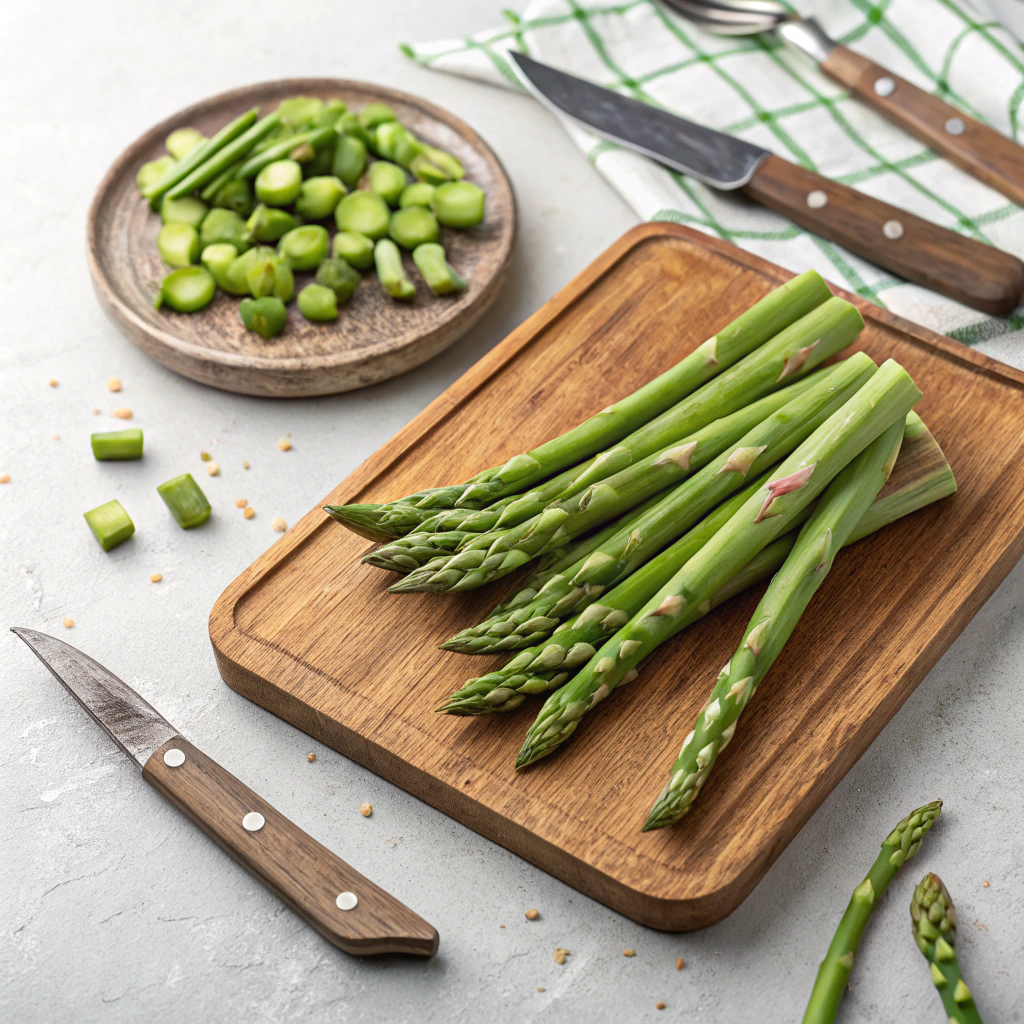
Cut asparagus stalks into 1-inch pieces, keeping the tips separate. If you’re a fan of mushrooms like I am, slice them evenly for consistent cooking. The sliced asparagus stalks will cook differently than the tender tips, so we’ll add them at different times.
3. Sauté the Mushrooms
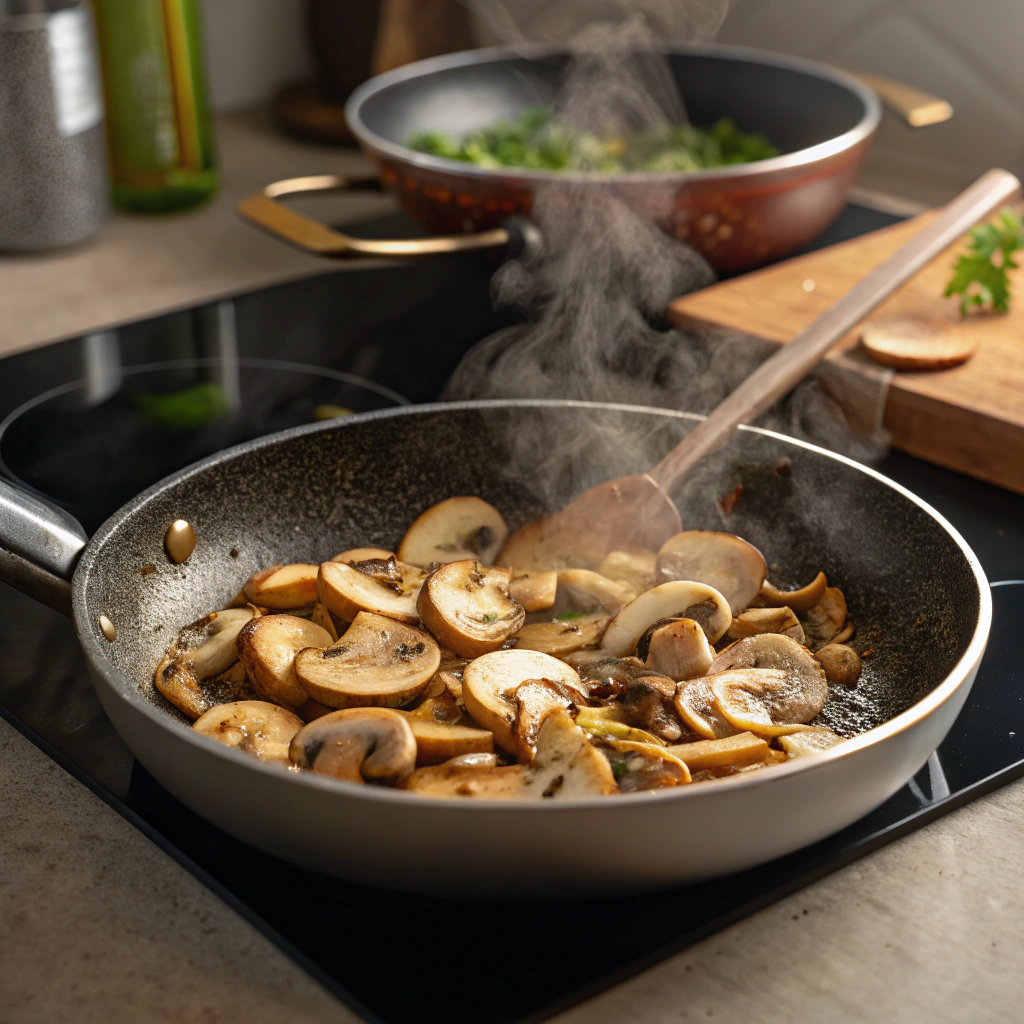
Heat a large skillet over medium-high heat with a tablespoon of olive oil. Add the earthy mushrooms and cook until golden brown, about 5-7 minutes. Season with salt and pepper, then set aside. This step intensifies their flavor significantly.
4. Cook the Asparagus
In the same skillet, add the asparagus stalks with a small amount of water. Steam for 2-3 minutes until bright green and slightly tender. Add the tips for the last minute. Set aside with the mushrooms.
5. Start the Risotto Base
In your large saucepan, heat olive oil and butter over medium heat. Add diced onion and cook until translucent, about 3-4 minutes. Add garlic and cook for another minute until fragrant.
6. Toast the Rice
Add the arborio rice to the pan and stir constantly for 2-3 minutes until the grains are coated and slightly translucent around the edges. This toasting step is crucial for developing flavor.
7. Add the Wine
Pour in the white wine and stir until it’s completely absorbed. The acid in the wine helps release starch from the rice, contributing to that creamy texture we’re after.
8. Add the Stock Gradually
Here’s where patience pays off. Add the first ladle of stock to the rice, stirring constantly until it’s absorbed. Continue adding stock one ladle of broth at a time, stirring continuously. This process takes about 18-20 minutes.
9. Test for Doneness
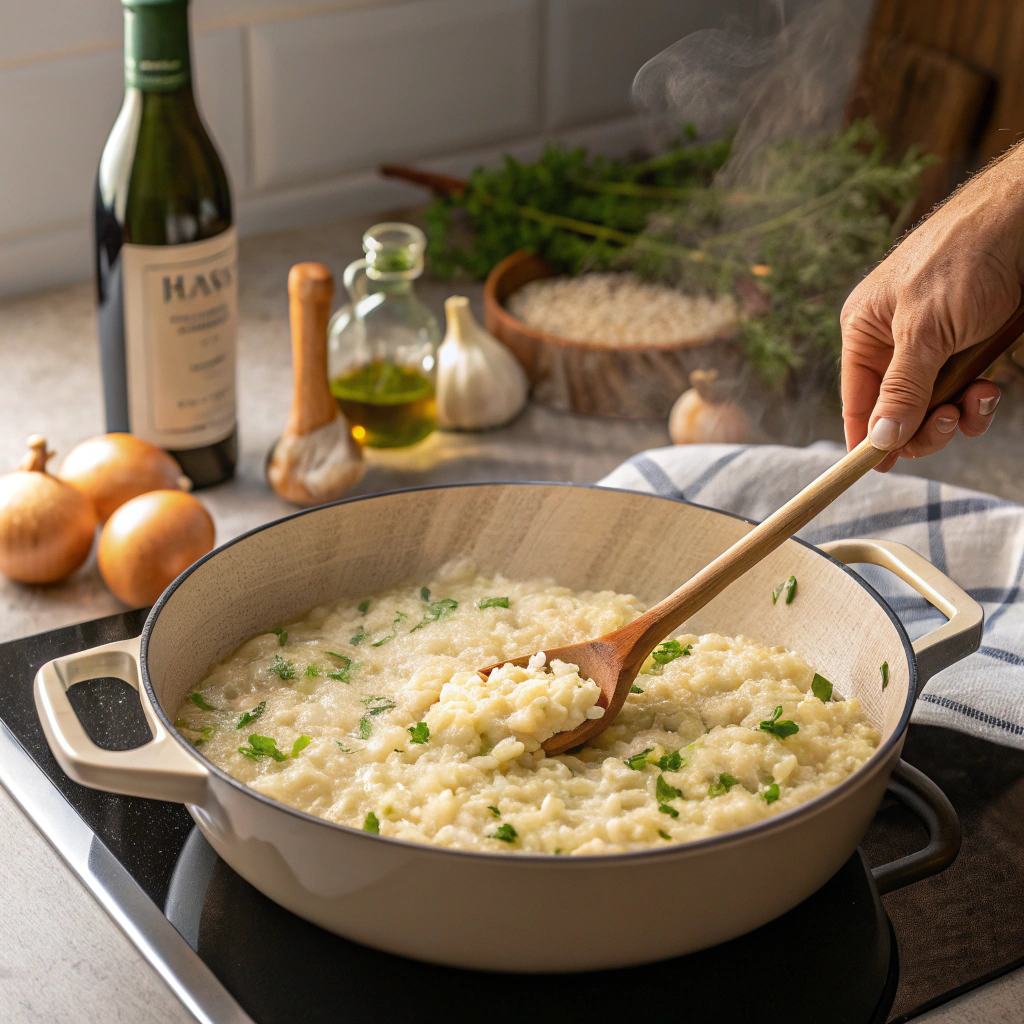
The rice should be al dente – tender but with a slight bite. If you need more liquid, continue adding warm broth or even hot water.
10. Finish with Style
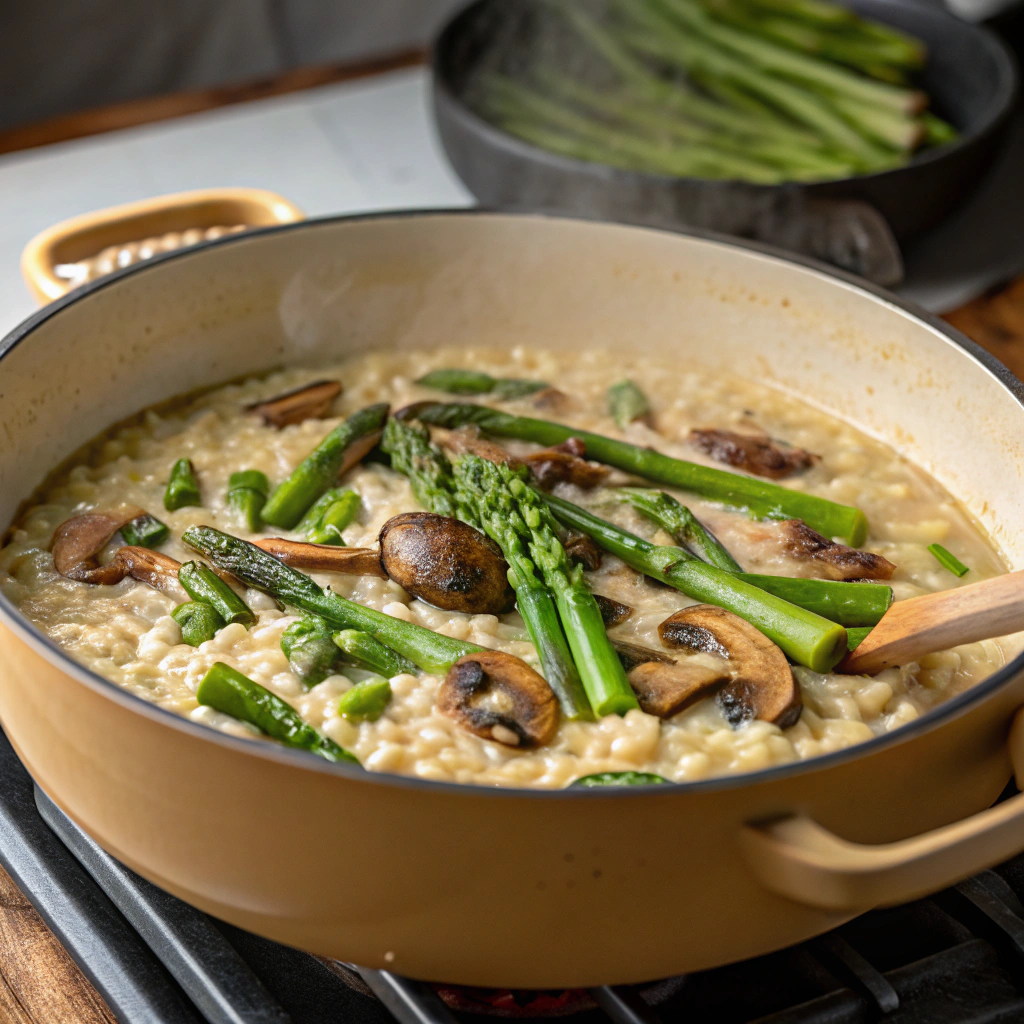
Remove from heat and immediately stir in the cooked mushrooms, asparagus, remaining butter, parmesan cheese, and lemon zest. The residual heat will warm the vegetables perfectly.
Creating the Ultimate Creamy Texture
The secret to achieving that restaurant-quality creamy risotto lies in understanding when to stop adding liquid. The rice should be creamy but not soupy, with each grain distinct yet bound by the natural starch.
Pro Tips for Extra Creaminess:
- Never rinse your arborio rice before cooking
- Keep your broth at a gentle simmer throughout
- Stir in one direction consistently
- Add cold butter at the end (called “mantecatura” in Italian)
Dietary Adaptations for Asparagus Mushroom Risotto
Vegan Asparagus Mushroom Risotto
Creating a vegan risotto doesn’t mean sacrificing flavor or creaminess. Here’s how I adapt my recipe:
Vegan Substitutions:
- Replace butter with high-quality olive oil
- Use nutritional yeast instead of parmesan cheese
- Add a tablespoon of miso paste for umami depth
- Finish with cashew cream for extra richness
The cooking process remains identical, but these substitutions create a completely plant-based version that’s equally satisfying.
Gluten-Free Asparagus Mushroom Risotto
The good news? Traditional risotto is naturally gluten-free since it’s made with rice. However, always check your broth and wine labels to ensure they don’t contain gluten-derived ingredients.
Gluten-Free Tips:
- Verify your veggie broth is certified gluten-free
- Use gluten-free wine or omit entirely
- Double-check any additional seasonings
No Onion-No Garlic Asparagus Mushroom Risotto (FODMAP-Friendly)
If you are following a low-FODMAP diet, or a diet free of onion and garlic, this risotto can still deliver incredible flavor with some simple substitutions.
FODMAP-Friendly Substitutions:
- Replace the diced onion with the green parts of 2-3 scallions (green onions only)
- Substitute garlic with 1 teaspoon garlic-infused olive oil
- Use asafoetida (hing) powder – just a pinch – for that savory umami depth
- Add extra herbs like chives or the green parts of leeks for aromatic complexity
Cooking Modifications: The technique remains exactly the same, but sauté the scallion greens where you would normally add the onion. The garlic-infused oil can be used as part of your initial olive oil for cooking the base, giving you that garlic essence without the actual garlic compounds that cause digestive issues.
If you don’t have or don’t want to use scallions, don’t panic. Here are various replacements.
Scallion Alternatives:
- Chives – Use 2-3 tablespoons of fresh chopped chives for a mild onion-like flavor
- Leek greens – The dark green tops of leeks (not the white parts) provide gentle onion notes
- Fennel fronds – The feathery green tops add a subtle anise-like sweetness
- Celery leaves – Finely chopped celery leaves contribute aromatic depth without FODMAPs
- Fresh herbs blend – Combine parsley, basil, and oregano for complex flavor layers
- Garlic chives – If available, these provide more robust flavor than regular chives
For Maximum Flavor, you can also enhance the base with a tablespoon of fresh ginger (grated), which is low-FODMAP and adds wonderful aromatic complexity. Another option is to use carrot and celery as your aromatic base – dice them very finely and sauté them where you’d normally add the onion.
The key is building flavor through multiple herb layers rather than relying on a single substitute. A combination of chives and celery leaves often works particularly well in risotto.
Seasonal Variations and Creative Additions for Asparagus Mushroom Risotto
One of the beautiful aspects of this easy risotto recipe is its adaptability throughout the seasons.
Spring Variations:
- Add fresh peas and mint
- Include baby spinach for extra greens
- Try spring onions instead of regular onions
Summer Adaptations:
- Incorporate zucchini and fresh basil
- Add cherry tomatoes for brightness
- Include fresh corn kernels
Fall and Winter Options:
- Use butternut squash and sage
- Add roasted root vegetables
- Include dried mushrooms for intensity
Troubleshooting Common Risotto Problems
Even experienced cooks sometimes face challenges. Here are solutions to common issues:
Too Thick or Gummy?
- Add more warm broth gradually
- Reduce stirring intensity
- Check if rice is overcooked
Too Thin or Soupy?
- Continue cooking without adding liquid
- Increase heat slightly to evaporate excess moisture
- Add grated cheese to help bind
Lacks Flavor?
- Season each addition of broth lightly
- Toast rice longer for nuttier flavor
- Add more aromatics like garlic or herbs
Serving Suggestions and Pairings for Asparagus Mushroom Risotto
This asparagus mushroom risotto works wonderfully as both a main dish and an elegant side dish. I love serving it alongside:
Perfect Pairings:
- Grilled chicken or fish for non-vegetarians
- A crisp white wine like Pinot Grigio
- Simple arugula salad with lemon vinaigrette
- Crusty Italian bread for texture contrast
Storage and Reheating: Making Your Asparagus Mushroom Risotto Last
Contrary to popular belief, risotto can be stored and reheated successfully with the right technique.
Storage Tips:
- Cool completely before refrigerating
- Store in an airtight container for up to 3 days
- Freeze portions for up to 1 month
Reheating Method:
- Add a small amount of broth or water
- Heat gently on stove top, stirring frequently
- Never microwave directly – it ruins the texture
Creative Leftover Ideas for Asparagus Mushroom Risotto
Don’t let leftover risotto go to waste! Transform it into:
Risotto Cakes:
Form cold risotto into patties and pan-fry until golden. These make excellent appetizers or breakfast dishes.
Risotto-Stuffed Vegetables:
Use leftover risotto to stuff bell peppers, tomatoes, or zucchini boats.
Rice Pudding Transformation:
Add milk and sugar to create a dessert version – though this works better with basic risotto without vegetables.
Nutritional Benefits of Asparagus Mushroom Risotto
This asparagus mushroom risotto isn’t just delicious – it’s nutritious too.
Nutritional Content per Serving:
| Nutrient | Amount |
| Calories | 320 |
| Protein | 12g |
| Carbohydrates | 58g |
| Fiber | 4g |
| Fat | 8g |
| Vitamin K | 45% DV |
| Folate | 25% DV |
| Potassium | 15% DV |
| Iron | 10% DV |
Health Benefits:
- Asparagus provides folate and vitamin K
- Mushrooms offer B vitamins and selenium
- Rice provides steady energy from complex carbohydrates
- Moderate protein content makes it satisfying
Advanced Techniques for Restaurant-Quality Asparagus Mushroom Risotto
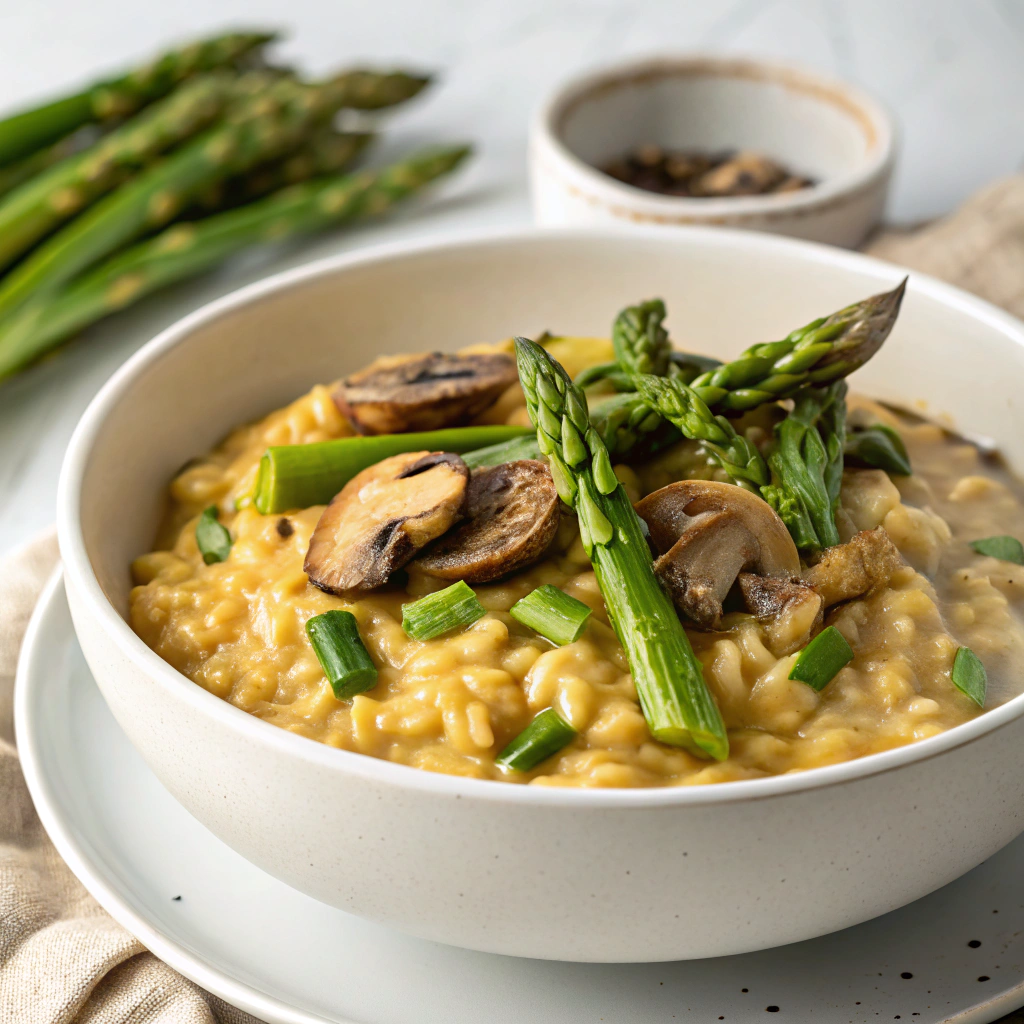
Want to elevate your mushroom risotto recipe to restaurant standards? I’m revealing to you some professional techniques:
Risotto Mantecatura:
This Italian technique involves vigorously stirring cold butter and cheese into finished risotto off the heat. It creates incredible creaminess and glossy appearance.
Proper Stock Temperature:
Keep your cooking liquid at a gentle simmer in a separate pot. Adding cold stock stops the cooking process and affects texture.
The Perfect Stir:
Use a wooden spoon and stir in consistent circular motions. This releases starch evenly and prevents sticking.
Shopping Tips for Asparagus Mushroom Risotto
Believe me, quality ingredients make a significant difference in your final dish. Here’s how to select your ingredients:
Selecting Asparagus:
- Choose bright green stalks with tight tips
- Avoid woody or yellowing stems
- Store upright in water like flowers
Choosing Mushrooms:
- Select firm mushrooms without dark spots
- Mix varieties for complex flavor
- Store in paper bags, not plastic
Rice Selection:
- Arborio is the classic choice
- Carnaroli offers even more starch
- Vialone Nano is traditional in Veneto
The Economics of Homemade Asparagus Mushroom Risotto
Making asparagus mushroom risotto at home costs significantly less than restaurant versions while offering superior control over ingredients and quality. I’ve done a quick calculation, and thanks to this recipe, here’s what you’ll save:
Cost Breakdown:
- Fresh ingredients from farmers market: $8-12
- Restaurant equivalent: $18-25
- Additional cost savings through bulk buying rice and staples
Conclusion: How to Master Asparagus Mushroom Risotto
Creating the perfect asparagus mushroom risotto is both art and science. It requires patience, attention to detail, and quality ingredients, but the rewards are immeasurable. The creamy texture, the harmony of spring vegetables, and the satisfaction of mastering this classic technique make every minute of stirring worthwhile.
Whether you’re preparing this as a weeknight dinner or an elegant entertaining option, remember that risotto is forgiving. Each time you make it, you’ll develop better instincts for timing, texture, and flavor balance. The cooking process itself becomes meditative, a peaceful end to busy days.
I encourage you to make this recipe your own. Experiment with seasonal vegetables, try different mushroom varieties, or adapt it for dietary restrictions. The foundation I’ve shared will support countless variations as you develop your own risotto style.
The next time you’re at the farmers market and see beautiful asparagus alongside fresh mushrooms, you’ll know exactly what to do. Trust the process, embrace the stirring, and prepare to fall in love with homemade risotto.
Explore Related Recipes
Frequently Asked Questions about Asparagus Mushroom Risotto
1. Can I make asparagus mushroom risotto ahead of time?
While risotto is best served immediately, you can prepare it up to the point where it’s almost done, then finish it just before serving. Stop adding broth when the rice is slightly underdone, spread it on a sheet pan to cool quickly, then reheat gently with additional warm broth when ready to serve. This technique is used in restaurants to manage timing.
2. What’s the best substitute for white wine in this Asparagus Mushroom Risotto recipe?
If you prefer not to use wine, substitute with an equal amount of additional warm broth or a mixture of broth and lemon juice. The acid helps release starch from the rice, so adding a tablespoon of white wine vinegar to the broth can provide similar results. Some cooks use dry vermouth as an excellent alternative.
3. How do I prevent my Asparagus Mushroom Risotto from becoming gummy or sticky?
Gummy risotto usually results from over-stirring, using too much liquid at once, or cooking at too high heat. Stir gently but consistently, add liquid gradually, and maintain medium heat throughout the cooking process. Also, avoid rinsing the rice before cooking, as you want to retain the starch that creates creaminess.
4. Can I use a rice cooker or pressure cooker to make this Asparagus Mushroom Risotto?
While traditional stovetop method gives the best control over texture, you can adapt this recipe for other cooking methods. In a pressure cooker, sauté the aromatics first, add rice and toast briefly, then add all liquid at once and cook under pressure for 6 minutes. For rice cookers, use the same liquid ratios but expect a different, less creamy texture since you can’t stir during cooking.
5. How can I tell when my Asparagus Mushroom Risotto has the perfect consistency?
Perfect risotto should flow like lava when stirred but hold its shape on the plate. The rice should be al dente – tender with a slight bite in the center. When you draw your spoon through the risotto, it should slowly close the gap you’ve created. If it’s too thick, add more warm broth; if too thin, cook a bit longer without additional liquid until it reduces to the right consistency.
Printable Recipe Card for Asparagus Mushroom Risotto
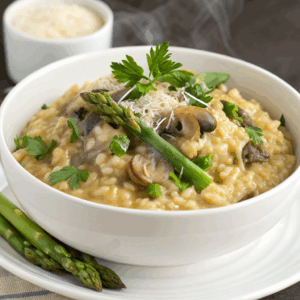
Asparagus Mushroom Risotto Recipe | Super Creamy
Equipment
- Must-Have Equipment:
- Large saucepan or medium saucepan (heavy-bottomed preferred)
- Wooden spoon for stirring
- Large pot for heating broth
- Sharp knife and cutting board
- Cheese grater
- Large skillet for sautéing mushrooms
- Ladle for pouring broth
- Saute pan for vegetables
- Optional but Helpful:
- Rice cooker (for an alternative method)
- Pressure cooker (for quicker cooking)
Ingredients
For the Base:
- 1½ cups arborio rice
- 6 cups warm veggie broth or chicken broth
- ½ cup white wine
- 1 medium onion finely diced
- 3 cloves garlic minced
- 2 tablespoons olive oil
- 1 tablespoon butter
- ½ cup freshly grated parmesan cheese
- Sea salt and black pepper to taste
For the Vegetables:
- 1 pound fresh asparagus woody ends removed
- 8 oz mixed fresh mushrooms cremini, shiitake, or porcini
- 1 tablespoon olive oil
- 1 clove garlic minced
- Small amount of water for steaming asparagus
For Finishing:
- 2 tablespoons butter
- ¼ cup parmesan cheese
- 1 teaspoon lemon zest
- 2 tablespoons heavy cream optional
- Fresh herbs for garnish
Instructions
Start with the Mise en Place
- The key to great risotto is preparation. Heat your veggie broth in a large pot and keep it warm on medium-low heat. This ensures each spoonful of stock you add maintains the cooking temperature.
Prepare the Vegetables
- Cut asparagus stalks into 1-inch pieces, keeping the tips separate. If you’re a fan of mushrooms like I am, slice them evenly for consistent cooking. The sliced asparagus stalks will cook differently than the tender tips, so we’ll add them at different times.
Sauté the Mushrooms
- Heat a large skillet over medium-high heat with a tablespoon of olive oil. Add the earthy mushrooms and cook until golden brown, about 5-7 minutes. Season with salt and pepper, then set aside. This step intensifies their flavor significantly.
Cook the Asparagus
- In the same skillet, add the asparagus stalks with a small amount of water. Steam for 2-3 minutes until bright green and slightly tender. Add the tips for the last minute. Set aside with the mushrooms.
Start the Risotto Base
- In your large saucepan, heat olive oil and butter over medium heat. Add diced onion and cook until translucent, about 3-4 minutes. Add garlic and cook for another minute until fragrant.
Toast the Rice
- Add the arborio rice to the pan and stir constantly for 2-3 minutes until the grains are coated and slightly translucent around the edges. This toasting step is crucial for developing flavor.
Add the Wine
- Pour in the white wine and stir until it’s completely absorbed. The acid in the wine helps release starch from the rice, contributing to that creamy texture we’re after.
Add the Stock Gradually
- Here’s where patience pays off. Add the first ladle of stock to the rice, stirring constantly until it’s absorbed. Continue adding stock one cup of broth at a time, stirring continuously. This process takes about 18-20 minutes.
Test for Doneness
- The rice should be al dente – tender but with a slight bite. If you need more liquid, continue adding warm broth or even hot water.
Finish with Style
- Remove from heat and immediately stir in the cooked mushrooms, asparagus, remaining butter, parmesan cheese, and lemon zest. The residual heat will warm the vegetables perfectly.
Notes
- Never rinse your arborio rice before cooking
- Keep your broth at a gentle simmer throughout
- Stir in one direction consistently
- Add cold butter at the end (called “mantecatura” in Italian)

